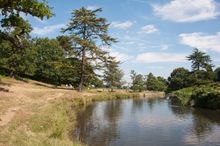 17 Oct 2025
17 Oct 2025
Tags: car free, MiniBreak, Nature, National Forest

Car-free holidays offer visitors the chance to fully immerse themselves in the Forest's rolling hills, tranquil lakes, and vibrant woodlands, while reducing their environmental footprint. Whether it's a weekend getaway or a longer stay, travellers can combine eco-friendly transport with accommodation, food, and activities that highlight the best of the National Forest.
“Exploring the National Forest without a car is a wonderful way to slow down, connect with nature, and experience the area in a more mindful, sustainable way,” said Richard Drakeley, tourism development manager the National Forest. “We've developed a network of trails, cycle routes, and accessible public transport options so visitors can enjoy everything the Forest has to offer without needing to drive.”
And if you're looking for a weekend that combines scenic walks, rich heritage and a touch of vintage travel then Charnwood Forest, just northwest of Leicester, is an ideal getaway for families, walkers and heritage lovers alike. This two-day itinerary offers a journey through ancient woodlands, dramatic rocky outcrops and the golden age of steam, all set within the unique landscape of the Charnwood Forest Geopark.
Designated as part of the Charnwood Forest Geopark, the area is nationally significant for its rare Precambrian rocks, which tell a story over 600 million years old. It's one of the few places in the UK where you can see the fossilised remains of some of the earliest known forms of complex life. But it's not just about geology, the forest also bears the marks of medieval history, centuries of slate quarrying and the legacy of Victorian railways. This weekend itinerary connects these layers of natural and human heritage in an accessible and rewarding way.
Day one - dramatic scenery and incredible history at Bradgate Park
Start your journey by catching a bus from Leicester to the village of Newtown Linford, the main entrance to Bradgate Park and a convenient place to stay overnight.
Bradgate Park is at the heart of the Charnwood Forest Geopark and makes an unforgettable introduction to the landscape. The park's rugged terrain is underpinned by some of the oldest exposed rocks in England. Look out for jagged grey outcrops of Precambrian volcanic rock, which predate the dinosaurs and help explain the area's geological importance. In 2024, Bradgate Park and adjacent Swithland Wood were officially designated as England's 220th National Nature Reserve, becoming part of the King's Series of National Nature Reserves, a prestigious honour recognising the site's globally rare fossils, ancient woodlands and outstanding biodiversity.
But Bradgate is just as rich in human history. The park was once a medieval deer park, and today red and fallow deer still roam freely through the bracken and grassland. Explore the atmospheric ruins of Bradgate House, the early-Tudor mansion built by the Grey family in the 16th century, and birthplace of Lady Jane Grey, who was briefly Queen of England in 1553 before being overthrown and executed at just 17.
Climb to Old John Tower, an eccentric 18th-century folly with spectacular panoramic views across Leicestershire. The nearby Cropston Reservoir adds to the park's sense of scale, and riverside trails along the River Lin offer a more tranquil walking experience.
Don't miss the visitor centre, where exhibitions explore the park's geology, history and wildlife. For a well-earned rest, stop in at the Deer Barn Café or enjoy a meal at The Bradgate, a popular country pub just outside the park offering seasonal menus and a relaxed atmosphere.
For overnight stays, Wigwam Holidays Charnwood Forest now offers one-night bookings in comfortable glamping cabins, set in peaceful woodland surroundings just a short walk from the park's western edge.
Day two - steam heritage and ancient woodland at Quorn and Swithland Woods
Begin your second day with a 15-minute bus journey to Quorn, where two key features of the Geopark meet - industrial history and natural beauty.
Walk from the bus stop to Quorn & Woodhouse Station, one of the most scenic stops on the Great Central Railway, the UK's only double-track heritage railway. Here, you can step into the past aboard a fully operational steam train, travelling in vintage carriages through the countryside. The full journey from Quorn to Loughborough and back takes around 25 minutes (12 minutes each way, plus turnaround time), but for those wanting to explore further, a Day Runabout ticket offers unlimited travel along the line, including other characterful stations like Rothley and Leicester North. The experience is pure nostalgia, complete with heritage uniforms, restored signal boxes and a fully working steam engine. The full line journey takes approximately one hour, offering a leisurely and immersive glimpse into the golden age of steam.
After your ride, stretch your legs on a pleasant 1.5-mile walk to Swithland Woods, part of an ancient woodland landscape shaped by both natural forces and industrial activity. The route via Buddon Lane is mostly level and passes near former slate quarries, whose scars in the landscape offer visible reminders of the area's quarrying past.
Swithland Woods is a designated Site of Special Scientific Interest and forms part of the Wildlife Trust's estate. Its mix of native trees, wildflowers and open glades supports a wide variety of wildlife, and its peaceful paths are popular with families and nature enthusiasts alike.
The woods are also important to the history of slate production. Swithland slate, once quarried here, was prized across the country for its durability and beauty. You'll still see it today on headstones in churchyards across Leicestershire.
After exploring the woods, take time for lunch at a country pub, either in nearby Swithland village or back in Quorn, both of which offer excellent options. The Manor House at Quorn, just a short walk from the station, is the closest pub and offers a seasonal menu, cosy interiors and a spacious garden. It also provides stylish guest accommodation, making it a convenient option for those looking to extend their stay. Another option nearby is Rothley Wine, an award-winning vineyard just a short taxi or cycle ride from the station, where you can enjoy tastings and vineyard tours in a peaceful rural setting.
When you're ready to return, the Centrebus will take you back to Leicester in under an hour.
Essential travel and access information
- Charnwood Forest Geopark: More information about the area's geological importance can be found at www.charnwoodforest.org
- Great Central Railway: Adult return fare £18 (2025). Timetables at gcrailway.co.uk.
- Bradgate Park: Free entry. Visitor centre, cafés and toilets available. See bradgatepark.org for maps and updates.
- Swithland Woods: Free access. Managed by Bradgate Park Trsut.
- Buses: Centrebus 154 runs hourly between Leicester, Newtown Linford and Quorn on weekends.
- Walking conditions: Paths in Bradgate Park and Swithland Woods can be uneven — wear sturdy footwear, especially in wet weather.
- Evening meal suggestion: thebradgate.com
- Accom suggestion: wigwamholidays.com/charnwood-forest
- The Manor House at Quorn: themanorhouseatquorn.co.uk
- Rothley Wine: https://rothleywine.com/
Whether you're drawn by the call of the steam whistle, the chance to spot deer in the wild, or the serenity of ancient woods, this Charnwood Forest itinerary packs a rich mix of history, heritage and natural beauty into one easy-going weekend.
Notes to Editor:
The National Forest covers 200 square miles of Derbyshire, Leicestershire, and Staffordshire, bringing the benefits of trees, woodland, and multi-use forestry to lowland England, where thousands of people live and work. Its creation began in the early 1990s as a radical vision to regenerate a post-industrial Midlands landscape—once scarred by coal mining and heavy industry—turning it from black to green.
It was the first broadleaf forest to be created at scale in England for more than 900 years and is now recognized as one of the boldest environmentally led regeneration initiatives in the country. The Forest stands as a national demonstration of how the natural environment can drive regeneration, showcasing policy, practice, research, and development in the heart of the country.
More than 9.85 million trees have been planted so far, increasing forest cover from just six percent in the 1990s to 25 percent today, with the target of reaching around one-third forest cover in the future. The Forest now welcomes more than 8.2 million visitors annually, supports a thriving forest economy, and sequesters more than 200,000 tonnes of carbon.
Trees have been the catalyst for change and transformation. The National Forest is a positive response to the climate crisis, putting in place the building blocks for climate mitigation and adaptation. Through partnerships, the Forest is creating wildlife habitats, reducing flooding, improving air quality, storing carbon, and creating space for outdoor education, with 90% of primary schools in the Forest embracing outdoor learning as part of their regular curriculum.
It is supporting the health and wellbeing of communities and enabling Forest-related businesses to thrive.
The National Forest is also playing a key role in the development of the Western Forest, one of England's new national forests. This ambitious initiative will be created across Wiltshire, Gloucestershire, and the West of England, which includes Bristol, Bath and North East Somerset, North Somerset, and South Gloucestershire. It will build on the National Forest's success by scaling up woodland creation and connecting landscapes to deliver greater environmental and community benefits.
This year marks the 30th anniversary of the formation of the National Forest Company, the charity leading the creation of the Forest, working in partnership with landowners, local authorities, businesses, and communities. It has strong support from government, politicians, and the public, and continues to be backed by the Department for Environment, Food and Rural Affairs (Defra).



